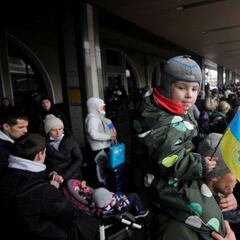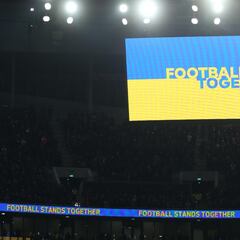Does Ukraine have a Neo-Nazi problem?
Russian president Putin has made baseless claims about "denazifying Ukraine" as a pretext to invade, but is there any history of neo-nazism in the country?


In his declaration of war against Ukraine, Russian President Vladimir Putin argued the need to demilitarise and "de-nazify" Ukraine. Considering the country has a Jewish president, the claim is baseless and is just a propaganda tool to gain support in country whose modern history is rooted in victory over the Nazis in the 'Great Patriotic War.'
Western support has been wholly behind the Ukrainians, and rightly so. Measures have ranged from intense sanctions, foreign fighters joining the Ukraine army, and a large fundraising campaign. People are standing with Ukraine in this pivotal time.
While Putin's words are merely propaganda, Ukraine does have a troubled relationship with nazism past and present, like many places in the world. Many modern Ukrainian heroes made their names collaborating with the Nazis against the Soviet Union, and this ideology still has roots which are embedded in fighting units that are being funded and equipped by the west.
Ukraine should be unequivocally supported, but there needs to be an honest assessment of the dangers Ukrainian Neo-Nazism poses, especially for a nation that will be swamped with weaponry once the war has ended.
See also:
Ukrainian nationalism has struggled to shake off its Nazi past
Before 1991, Ukraine had not been a nation in a united form for nearly 700 years. It existed divided up amongst the powers of the region: Poland, Muscovy (which became Russia), and Austria. By the time of the formation of a national consciousness and ideas of nation states, Ukraine was still under foreign control, but opportunities arose during both World Wars for that to be reversed.
For the period being discussed here, the crucial time is Summer 1941. Germany had just invaded the Soviet Union during the Second World War, and Ukrainian nationalists saw an opportunity to finally break free of Russian control. To do so, they collaborated with the Germans. This was the Organisation of Ukrainian Nationalists (OUN-B), led by Stepan Bandera. Bandera's legacy is divisive, and he is as liked as he is disliked inside the coutnry. But for Ukrainian ultranationalists he is a hero.
In a recent PBS news piece, this Ukrainian politician has Bandera's portrait hung in his office, clear to make out despite the blurring around him. Israel has criticised Ukrainian support for the figure.
When Russian troops came into the office of the mayor of Konotop, Ukraine, he escorted them out and made sure they drove away.
— PBS NewsHour (@NewsHour) March 3, 2022
"We are ready to fight till the end — till the victorious end — to defeat these Russian cockroaches," he tells @nickschifrin. https://t.co/KS5DIvofpZ pic.twitter.com/BqoU7NLL0c
It is worth noting that the vast majority of Ukrainians fought with the Red Army against Nazi Germany, eventually defeating them in 1945.
The Azov Battalion
This past leads up to 2014, when Russia occupied the Crimea, a large southern peninsular of Ukraine. Two separatist regions, supported by the Russians, rebelled against Ukraine and the Ukrainian Army raised new paramilitary forces to defend the land. One of these was the Azov battalion.
The group espouses fiercely right-wing beliefs, and draws much of their imagery from Nazi SS insignia from the Second World War, including their badge. The symbol is called the Wolfsangel, which was co-opted by the Nazis in an attempt to link their beliefs to ancient Norse pagan ideas.
The HQ of the #Ukraine paramilitary battalion #Azov complete with Wolf Hook or Wolfsangel symbol also used by Nazis pic.twitter.com/7Sp1UkHMOv
— Bojan Pancevski (@bopanc) August 10, 2014
The group had previously been banned by the House of Representatives from receiving training from US forces. There had been an outright ban of supporting the group, but this was lifted in 2017 despite protestations from the Simon Wiesenthal Centre.The unit has been integrated into the Ukrainian territorial army, and has been receiving weapons from the west to defend Ukraine.
Azov fighters, fascist fighters and other European fascists wear a sonnenrad / 'black sun' emblem. The Christchurch shooter, who massacred 51 Muslims, wore one. Not gonna forget those who've downplayed the presence, threat & power of European fascists armed with weapons of war. https://t.co/Onq7VdZ3WV
— Sana Saeed (@SanaSaeed) March 8, 2022
How big of a threat are groups like the Azov battalion?
According to a Ukrainian political scientist, the group has at most 2 percent electoral support, a small minority. But these are challenging times in Ukraine, and an invasion from a country who's leader has denied your country's right to exist is going to spur many towards nationalist beliefs. While nationalism is not dangerous in and of itself, it can be a path to the far-right, something right-wing groups like the Azov battalion will be well aware of.
This can be seen in other images shared of Ukrainian soldiers during the war. In a now deleted post from the official NATO twitter, another Nazi symbol, the Sonnenrad, can be seen on the uniform of Ukrainian soldiers. While numbers of supporters is similar to that in other European nations, the free access to weapons they have is a danger that the far-right does not posses in other countries.
NATO just tweeted a photograph of a Ukrainian soldier wearing a large NAZI badge on her uniform.
— Peter Cronau (@PeterCronau) March 9, 2022
Then deleted it. https://t.co/HrR5wHlmqb
Related stories
The existence of fascist paramilitaries in a war that could be for the existence of their country should give no credence to the Russian declaration of war. But the west should be aware of where, potentially, heavy weaponry could end up. Some commentators have said Ukraine will be Russia's Afghanistan, in relation to the Soviet invasion in 1979. The US armed the Mujahideen to fight the Soviets, realising after that it was a serious mistake.
Ukraine will be flooded with weaponry after the war, and having right-wing paramilitaries holding many of these could cause serious security issues for Ukraine and Europe in the years to come.

